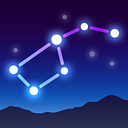The Mercury-Saturn conjunction will be especially challenging to view from northerly latitudes — such as those in the U.S. and Europe. From our latitudes, Mercury and Saturn lurk low in the southwest at sunset and follow the sun beneath the horizon less than an hour later. You’ll probably need binoculars for any chance of spotting them. Look first for the dazzling planet Venus, the brightest starlike object in the evening sky, as soon as the sky begins to darken (say, 15 to 45 minutes after sundown). Then look for Mercury and Saturn nearer the horizon, below Venus.
Moon and Jupiter Conjunction
The king planet Jupiter is the sole naked-eye planet to shine in the morning sky at present. Simply get up before sunrise over the next several days to note that super-brilliant “star” close to the waning crescent moon on the sky’s dome. That’ll be Jupiter.
The moon has been taking aim on Jupiter for the past several mornings, and it’s about to sweep past Jupiter before dawn. You can see them near each other on the morning of November 24 and again on November 25.
Thanksgiving day is here, and to express our appreciation for all of you, we have prepared a discount for our best-seller apps. Star Walk 2 will be on sale on November 24–25, so grab it not to miss the conjunction between Mercury and Saturn. On November 26–28 you can get Solar Walk 2 app with a discount.
Happy Thanksgiving to you and all those you love!
Read more here.
